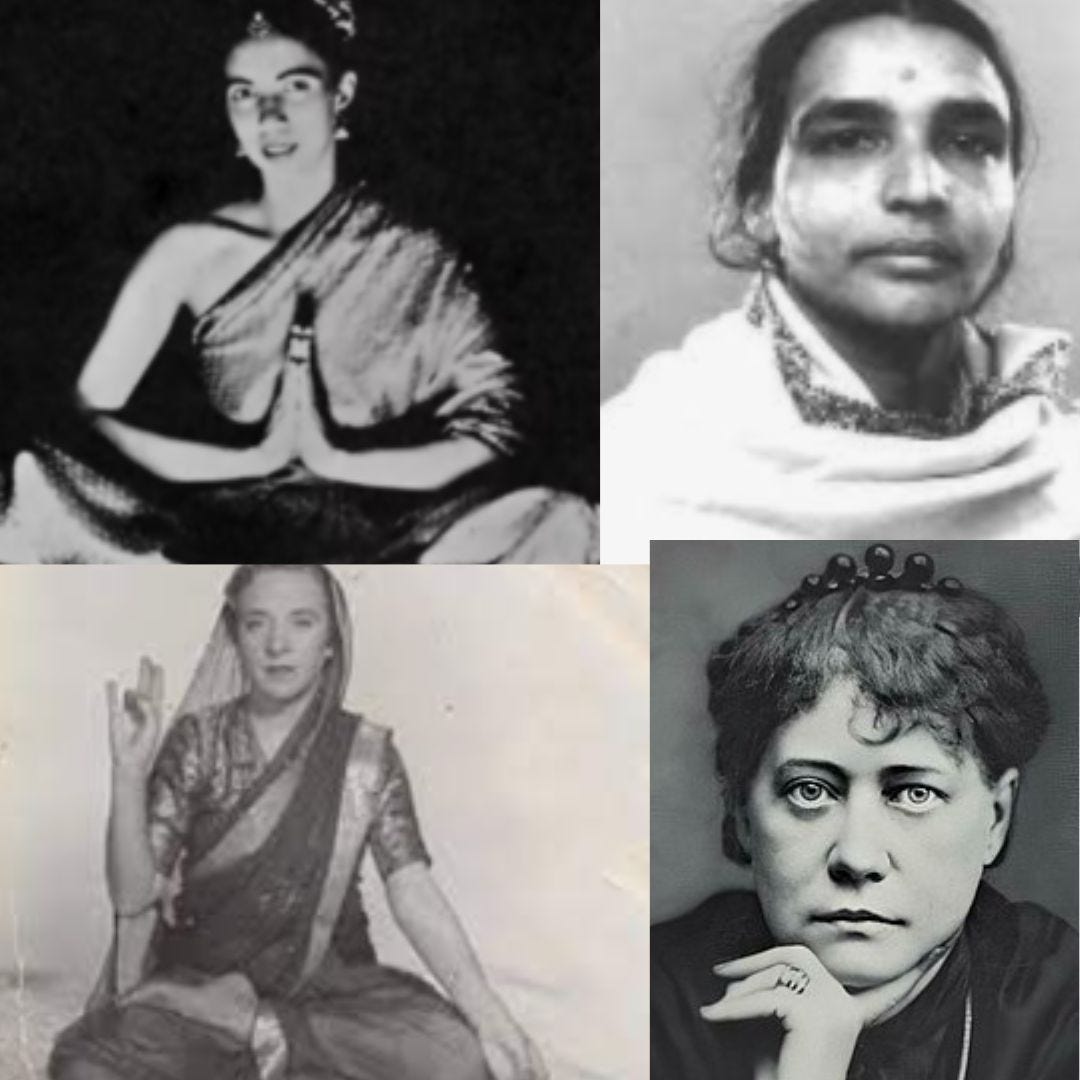A Herstory of Modern Yoga
Illuminating the lives of women who shaped yoga, in celebration of International Women's Day 2025
There are several women that had a huge impact on how yoga came to be known, and to be taught, inside and outside of India in the modern era (I’m thinking late 19th century onwards). They rarely have their stories told. I want to centre these women in the history of modern yoga, not to, in turn, silence the stories of men, but to present a more accurate picture of the past.
It is commonplace, on yoga teacher training courses, to learn about the father of modern yoga, T. Krishnamacharya, and his most well known students: T.K.V. Desikachar, B.K.S. Iyengar (founder of Iyengar yoga), P. Jois (founder of Ashtanga Yoga), who are all, of course, men. You may also know about Swami Vivekananda, who attended the 1893 Chicago Parliament of World Religions, and wrote a popular book for westerners about the Yoga Sutras.
The influences of these men are far-reaching.
Yoga teachers often trace the lineage of their own learning back to one, or more, of them. Or they look back to other male figures like Swami Sivananda, Swami Muktananda, or Swami Satyananda - all founders of their own yoga schools and lineages. But historical narratives are not linear and many voices get lost along the way. As well as presenting a more accurate historical narrative of modern yoga, I’d like to redress the balance with a herstory of yoga.
A herstory, or her-story, is history that pays specific attention to the experiences of women.
I’ll be doing this in a very timely manner in celebration of International Women’s Day, and Women’s History Month, on Thursday 6th March 1-2pm (UK time) online, as part of the the British Wheel of Yoga’s members session.
In the workshop I’ll talk about the influence of Madame Blavatsky, Indra Devi, Gita Iyengar, Mollie Baggot Stack, Yogini Sunita and a few other women you may not have heard of (all pictured above, apart from Baggot Stack). Below is an introduction to these five women.
Madame Blavatsky (1831-1891) is sometimes referred to as the mother of modern spirituality. She co-founded the Theosophy society in 1875, in New York, and gained an international following. The society generated theories, through publications and public talks, that blended science, philosophy and religion. Blavatsky claimed to have travelled to Tibet, that she was clairvoyant, and had access to secret knowledge. It was on this basis that she founded the society and claimed her position of power. Her followers saw her as a visionary mystic: others saw her as a charlatan.
Despite her reputation, Blavatsky and the Theosophists were (amongst other things) instrumental in shaping the popular view of what yoga was, to western audiences. The society published their own edition of, and keenly promoted, the Yoga Sutras in the mid 1800’s, years before Vivekananda travelled to and toured the US. She also had a low opinion of hatha yogis (I’ll talk more about this in the workshop in March).
Indra Devi (1899-2002) was the first foreign woman to be taught yoga by T. Krishnamacharya, at the behest of the Maharaja of Mysore in the 1930s. After a year of intense instruction, Krishnamacharya asked Devi to teach yoga where ever she went in the world, which she did. She eventually opened a studio in Hollywood, LA in the 1948 and published several yoga books.
Geeta Iyengar (1944-2018) was the daughter of B.K.S Iyengar. She pioneered yoga specifically for women at different life stages - pregnancy, motherhood and menopause. Yogini Sunita (1932-1970) taught yoga in Birmingham, UK in the 1960s. She had hundreds of students and taught a unique style of flowing postures, breathing and meditation techniques which she called Pranayama Yoga.
Mollie Baggot Stack (1883-1935) founded the Women’s League of Health and Beauty in 1930, in the UK. Her system of exercises were influenced by her time in India and many of what she taught looked very similar to yoga poses we are all familiar with today.
If you’d like to know more about these women and how they influenced the development of modern yoga please join me at the online workshop on 6th March.
The workshop is free for members and £25 for non-members.
If you’re a member of the British Wheel of Yoga you can sign up by logging into the portal your membership and go to the event here.
If you’re not a BWY member you can sign up by following these instructions:
Go to portal.bwy.org.uk
Click the red ‘join us’ button.
Scroll down and select a free account.
Create your free account.
Search for our workshop using the key terms, or my name, and book on!
In-person yoga classes at Calderdale Yoga Centre, Hebden Bridge in West Yorkshire
Yin Yoga, Fridays 6-7.15pm
7th February,
7th March
4th April
I contributed to a book, The Yoga Teacher’s Survival Guide: Social Justice, Science, Politics, and Power, edited by Theo Wildcroft and Harriet McAtee. My chapter is titled ‘Trauma, Yoga, and Spiritual Abuse’. Other contributors include Donna Farhi, Jules Mitchell, and Jivana Heyman. If you’re a yoga teacher, I highly recommend reading. You can buy your copy here from Bookshop.org (aff link).
P.S. If you KNOW that learning about the history of women in yoga, from pre-modern to modern times, is for you, early bird spaces are open for my online course Women in Yoga: an exploration starting 18th March.



